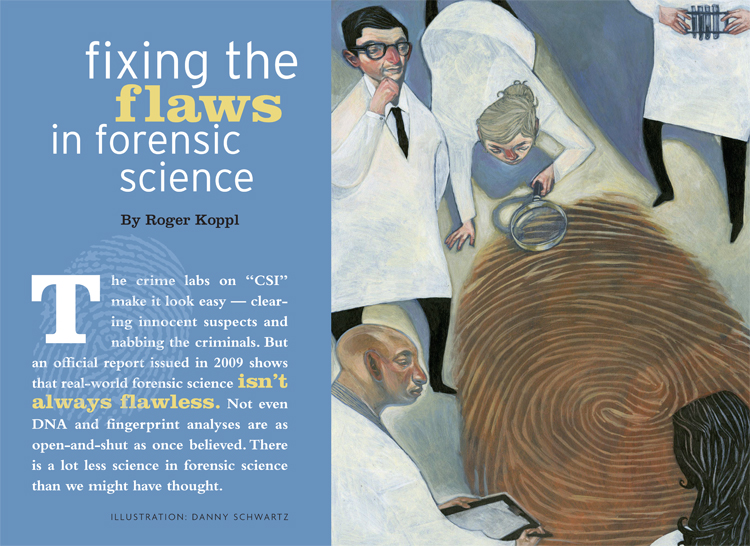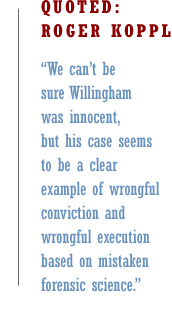

The nation is facing a shortage of nurses, coupled with an increased demand for health care. Find out how FDU is addressing the challenge.
The Campaign for Fairleigh Dickinson University is nearing its $50-million goal.
FDU’s Institute for Forensic Science Administration is applying the principles of economics and business to examine flaws in forensic science.
Ramatu Musa, BA’09 (T), interned at the U.S. Mission to the United Nations in Geneva, Switzerland. FDU Magazine shares her summer travelogue.
Pollster John Zogby has declared America’s youth to be the first global generation. Are they? FDU’s experts comment.Alumni Profile
Clean Power Cells
Gerald DeCuollo,
BS’77 (M)Alumni Profile
Glass Ceiling to Crown Heights
Rosemary Espanol,
BA’70 (M)

The report, produced by the National Academy of Sciences (NAS), which Congress and the president created in 1863 to be “advisers to the nation on science, engineering, and medicine,” finds “serious problems” with crime labs and forensic science. “With the exception of nuclear DNA analysis,” it says, “no forensic method has been rigorously shown to have the capacity to consistently, and with a high degree of certainty, demonstrate a connection between evidence and a specific individual or source.”
The report also notes, “although DNA analysis is considered the most reliable forensic tool available today, laboratories nonetheless can make errors … such as mislabeling samples, losing samples or misinterpreting the data.” The report does not exaggerate when it says that “there is a tremendous need for the forensic science community to improve” and the “current situation” is “seriously wanting.”

Unfortunately, there are plenty of real-life examples of injustice created by imperfect forensic science. In 2004, the FBI arrested Brandon Mayfield as a material witness in the Madrid train bombing of March 2004. He had been identified as the source of a latent print found on a bag of detonators near the crime scene. After assigning three of its top fingerprint examiners to the case, the FBI declared a “100 percent match” to Mayfield.
The Spanish National Police objected, however, and declared a match to a man named Ouhnane Daoud. The Spanish authorities’ suspicions were confirmed when the FBI withdrew its identification and released Mayfield. The NAS report says this case should “signal caution” about “the reliability of fingerprint evidence.” In spite of this case and others, FBI officials have insisted that the error rate for fingerprints is zero. The NAS report rightly points out that zero error rates are “not scientifically plausible.”

There are also the infamous cases involving Fred Zain, who “repeatedly falsified evidence” in criminal prosecutions in Texas and West Virginia. At least 10 men have had their convictions overturned as a result. We can hope Zain is an exceptional case, but it is alarming to note that his lies went undetected for more than 10 years.
And then there is Cameron Todd Willingham, who was executed in Texas in 2004. Charged with murdering his three small children by arson, he was convicted with forensic techniques that were current at the time of the fire in 1991, but discredited by the time of his execution in 2004. A 1992 report by the National Fire Protection Association found that many then-standard techniques of arson investigation were bogus. Some of these bogus techniques were used against Willingham. For example, fire investigators used to think that “crazed glass” proved that an arsonist used an accelerant to get the fire going. But dowsing hot glass with water, which may happen when firemen put out a house fire, can also cause those same intricately patterned cracks. We can’t be sure Willingham was innocent, but his case seems to be a clear example of wrongful conviction and wrongful execution based on mistaken forensic science.

Errors can happen even when the underlying science is solid, as it is for DNA. In Houston, Texas, problems forced the city’s lab to shut down DNA testing from December 2002 to July 2006. Before the shutdown, Josiah Sutton was convicted of rape largely on the lab’s DNA evidence, which was later shown to be inaccurate. Sutton was sent to jail when he was only 16 years old and stayed there for four years before being exonerated. Later, an audit of the crime lab exposed many problems, such as evidence contamination, sloppy reports and failing to follow procedure. One particularly alarming line from the report said, “The audit team was informed that on one occasion the roof leaked such that items of evidence came in contact with the water.”

hy are there so many problems in forensic science? The NAS report identifies three key features of the system today that contribute to forensic science errors: fragmentation, dependence on law enforcement and lack of oversight. Fragmentation means that techniques and practices may vary from jurisdiction to jurisdiction. That is a problem because we need uniform standards if forensic-science results are to be reliable and intelligible. Dependence on law enforcement means that crime labs are usually a part of the local police or the FBI or some other law-enforcement agency. The NAS report notes that such dependence creates “a general risk of bias.” Bias can be unconscious, thus even the most scrupulously conscientious forensic scientists may be biased toward the law-enforcement agencies that pay their salaries. Finally, lack of oversight means that crime labs doing sloppy work may be able to get away with it for years.
FDU Magazine is published twice yearly by the Office of Communications and Marketing, Fairleigh Dickinson University, 1000 River Road, H-DH3-14, Teaneck, N.J. 07666.
FDU Magazine welcomes your comments. E-mail Rebecca Maxon, editor, at maxon@fdu.edu or make a blog entry at MyFDU.net.
J. Michael Adams, President; Richard Reiss, Senior Vice President for University Advancement; Angelo Carfagna, Assistant Vice President for University Advancement and Communication; Okang McBride, Director of Alumni Relations; Carol Kuzen Black, Director of Publications/Senior Editor; Rebecca Maxon, Editor and Web Designer; Nina Ovryn, Art Director
Contributors: Mary Ann Bautista, Roger Koppl, Andrew McKay, Ramatu Musa, Tom Nugent, Melissa Payton
Photo/Illustration Credits: John S. Dykes, Don Hamerman, istockphotos.com, Shelley Kusnetz, Weaver Lilley, Katharine Marks, Arthur Petrosemolo, Nick Romanenko, Danny Schwartz, Adena Stevens
For a print copy of FDU Magazine, featuring these and other stories, contact Rebecca Maxon, editor, at maxon@fdu.edu.
To update your address e-mail fine@fdu.edu or update your profile online at www.MyFDU.net.
©Copyright 2010 Fairleigh Dickinson University. All rights reserved.



